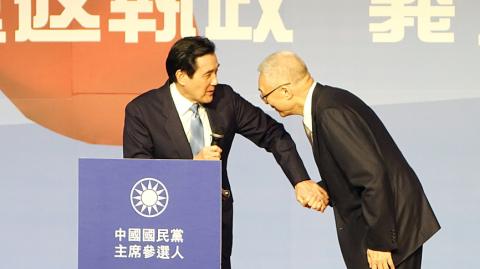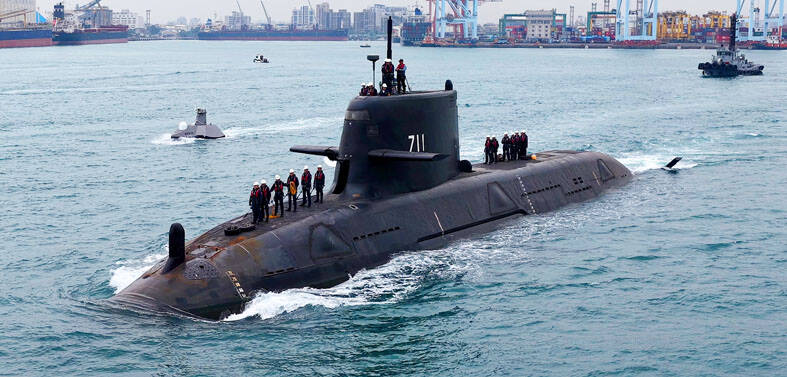Former president Ma Ying-jeou (馬英九) yesterday hurled insults at KMT Chairwoman Hung Hsiu-chu’s (洪秀柱) team and cross-strait policy platform at a solidarity rally held for Chinese Nationalist Party (KMT) chairperson candidate Wu Den-yih’s (吳敦義) campaign.
Ma took aim at a recent controversy, when it was revealed that “dummy members,” had been signed to the party en masse, saying that the practice “used to be the Democratic Progressive Party’s trick, not the KMT’s.”
Addressing accusations that members with organized crime backgrounds joined the party, Ma said the reports have had a terrible effect on the party, and such “pests” must be eradicated for the KMT to regain its “sunshine image.”

Photo: George Tsorng, Taipei Times
The KMT has “a clear understanding of right and wrong, upholds morality and takes its connections with party members seriously, characteristics that have arisen from the party’s 100-year history,” he said.
“However, there are some party comrades that have been ranting at their own brethren; there are even reports alleging that certain party members plan to launch a political vendetta against me, accusing me of being to blame for devastating the party and the nation,” Ma said.
One of the “comrades” Ma was referring to is understood to be KMT Central Policy Committee director Alex Tsai (蔡正元), who has been involved in a series of heated spats and exchanges with Ma’s office, the most recent regarding Ma’s acknowledgment that Chiang Kai-shek (蔣介石) should be held accountable for the 228 Incident.
Tsai responded that then-Taiwan governor Chen Yi (陳儀), who ordered police and military action against protesters, was less corrupt than Ma.
The vendetta that Ma mentioned is believed to relate to forums organized by Chang Ya-chung (張亞中), a close aide of Hung’s and the principal of the “Sun Yat-sen School” set up by Hung.
The school, launched at the beginning of this month, was said to be “for the appraisal of past KMT leaders and their achievements and misdeeds.”
The school evaluated former presidents Chiang Kai-shek on March 2, Chiang Ching-kuo (蔣經國) on March 9 and Lee Teng-hui (李登輝) on Thursday.
Ma is scheduled to be discussed on Thursday next week.
Ma also repeated that the so-called “1992” consensus has benefited Taiwan greatly and was “not a ‘consensus’ between the KMT and the Chinese Communist Party, but one reached, under the direction of former president Lee Teng-hui, between Taiwan’s Mainland Affairs Council and China’s Association for Relations Across the Taiwan Straits.”
“One China, different interpretations” has garnered a high level of support, he said, adding that it should not be “arbitrarily overlooked, revised or abolished.”
“It should not be changed to [Hung’s] ‘one China, same interpretation,’ which has left many of our supporters disconcerted,” Ma said.
The “1992 consensus” refers to a supposed understanding reached during the cross-strait talks in 1992 that both Taiwan and China acknowledge that there is “one China,” with each side having its own interpretation of what that means.
In 2006 former Mainland Affairs Council minister Su Chi (蘇起) admitted he made up the term in 2000, before the KMT handed power to the Democratic Progressive Party.

NUMBERS IMBALANCE: More than 4 million Taiwanese have visited China this year, while only about half a million Chinese have visited here Beijing has yet to respond to Taiwan’s requests for negotiation over matters related to the recovery of cross-strait tourism, the Tourism Administration said yesterday. Taiwan’s tourism authority issued the statement after Chinese-language daily the China Times reported yesterday that the government’s policy of banning group tours to China does not stop Taiwanese from visiting the country. As of October, more than 4.2 million had traveled to China this year, exceeding last year. Beijing estimated the number of Taiwanese tourists in China could reach 4.5 million this year. By contrast, only 500,000 Chinese tourists are expected in Taiwan, the report said. The report

SHIPS, TRAINS AND AUTOMOBILES: The ministry has announced changes to varied transportation industries taking effect soon, with a number of effects for passengers Beginning next month, the post office is canceling signature upon delivery and written inquiry services for international registered small packets in accordance with the new policy of the Universal Postal Union, the Ministry of Transportation and Communications said yesterday. The new policy does not apply to packets that are to be delivered to China, the ministry said. Senders of international registered small packets would receive a NT$10 rebate on postage if the packets are sent from Jan. 1 to March 31, it added. The ministry said that three other policies are also scheduled to take effect next month. International cruise ship operators

Temperatures are forecast to drop steadily as a continental cold air mass moves across Taiwan, with some areas also likely to see heavy rainfall, the Central Weather Administration (CWA) said. From today through early tomorrow, a cold air mass would keep temperatures low across central and northern Taiwan, and the eastern half of Taiwan proper, with isolated brief showers forecast along Keelung’s north coast, Taipei and New Taipei City’s mountainous areas and eastern Taiwan, it said. Lows of 11°C to 15°C are forecast in central and northern Taiwan, Yilan County, and the outlying Kinmen and Lienchiang (Matsu) counties, and 14°C to 17°C

STEERING FAILURE: The first boat of its class is experiencing teething issues as it readies for acceptance by the navy, according to a recent story about rudder failure The Hai Kun (海鯤), the nation’s first locally built submarine, allegedly suffered a total failure of stern hydraulic systems during the second round of sea acceptance trials on June 26, and sailors were forced to manually operate the X-rudder to turn the submarine and return to port, news Web site Mirror Daily reported yesterday. The report said that tugboats following the Hai Kun assisted the submarine in avoiding collisions with other ships due to the X-rudder malfunctioning. At the time of the report, the submarine had completed its trials and was scheduled to begin diving and surfacing tests in shallow areas. The X-rudder,